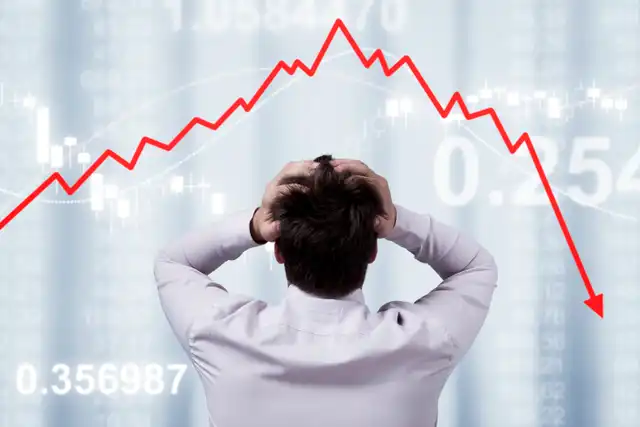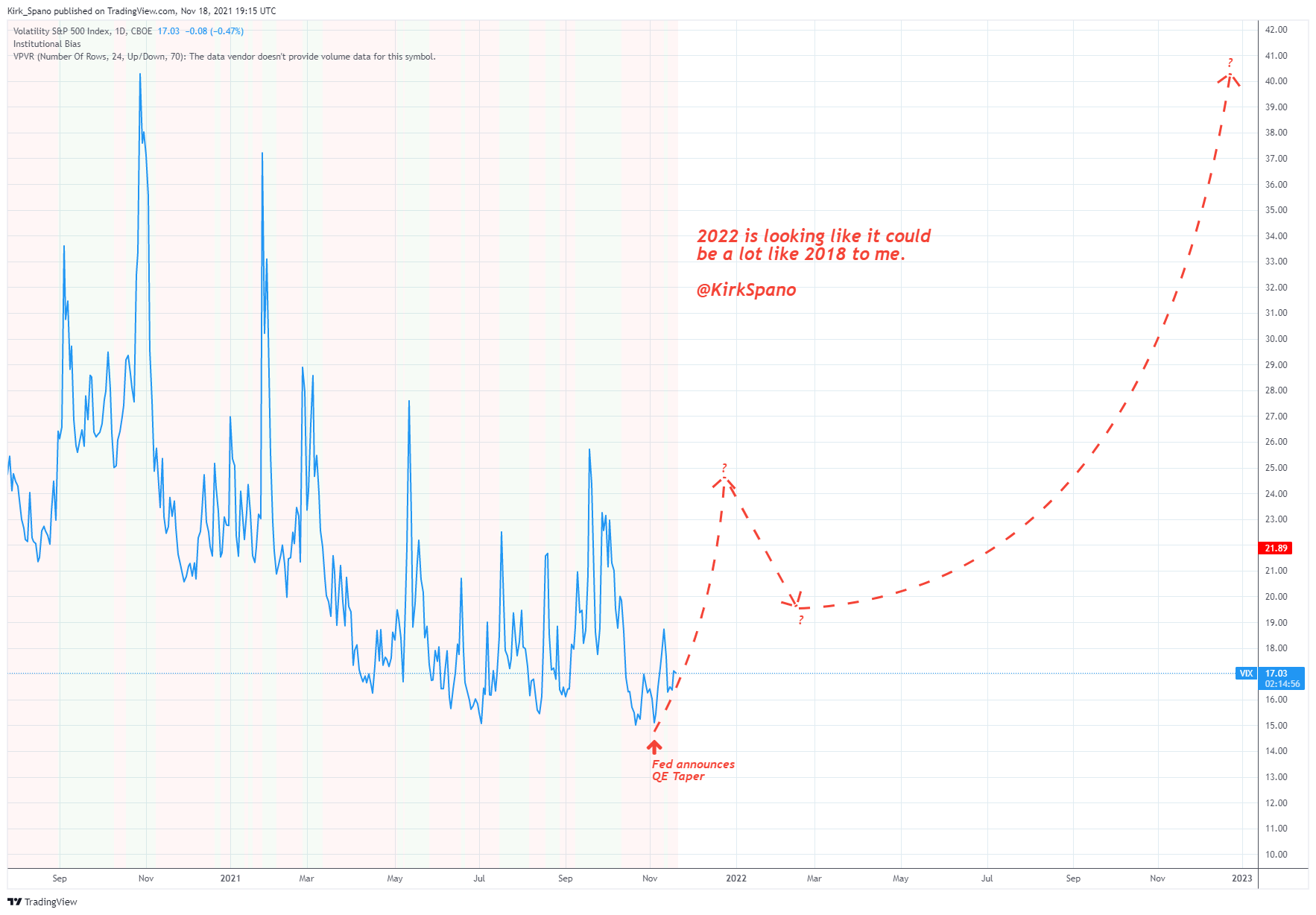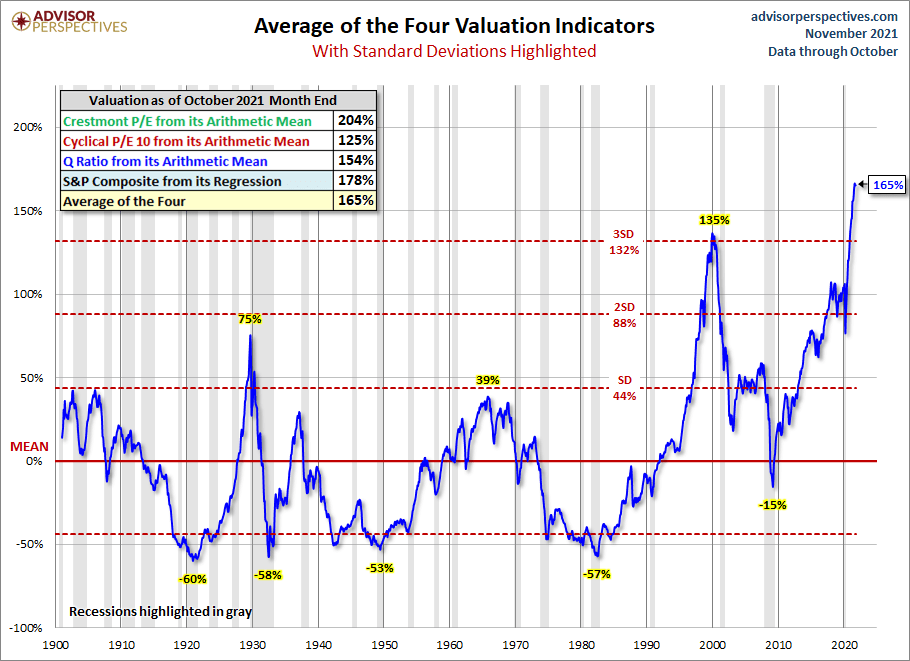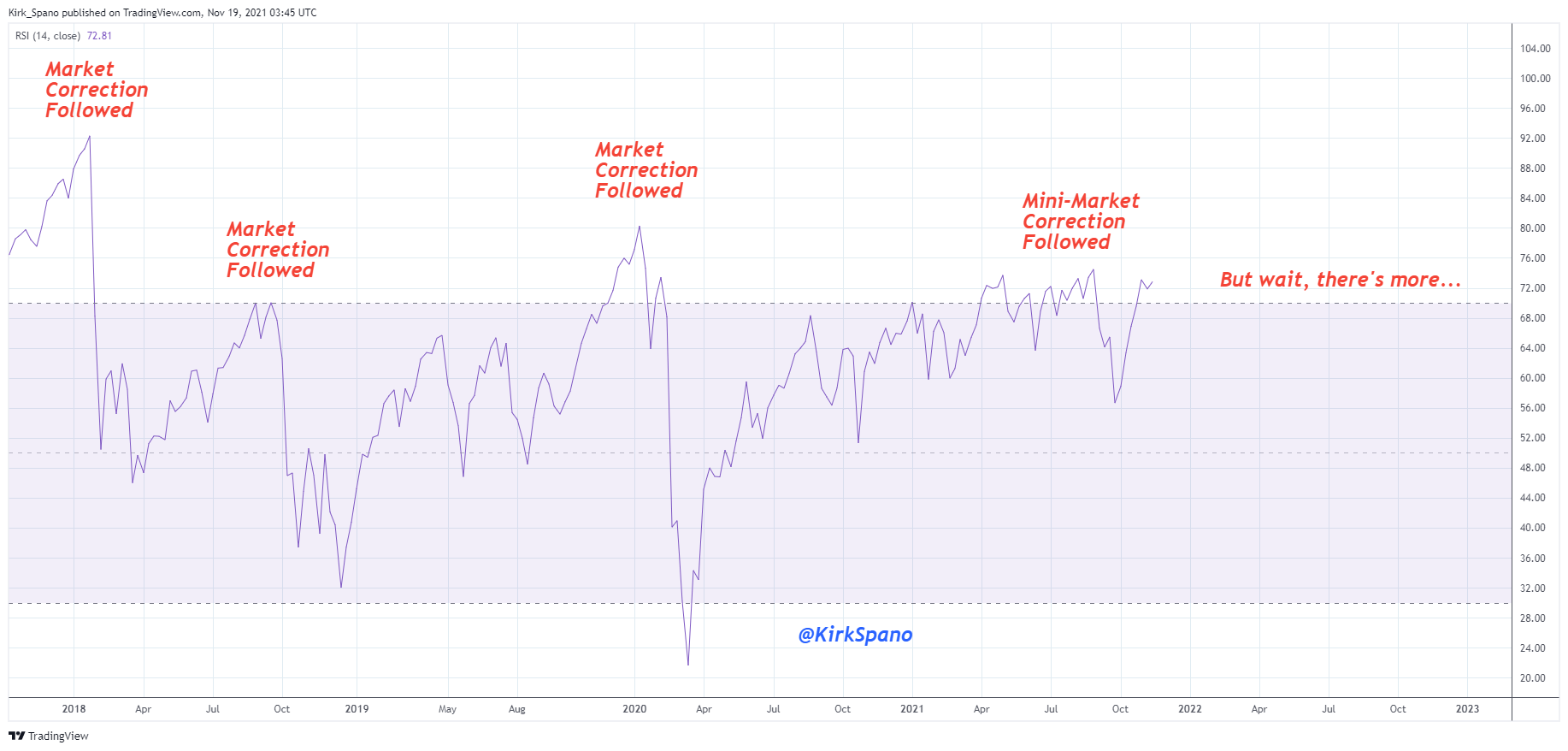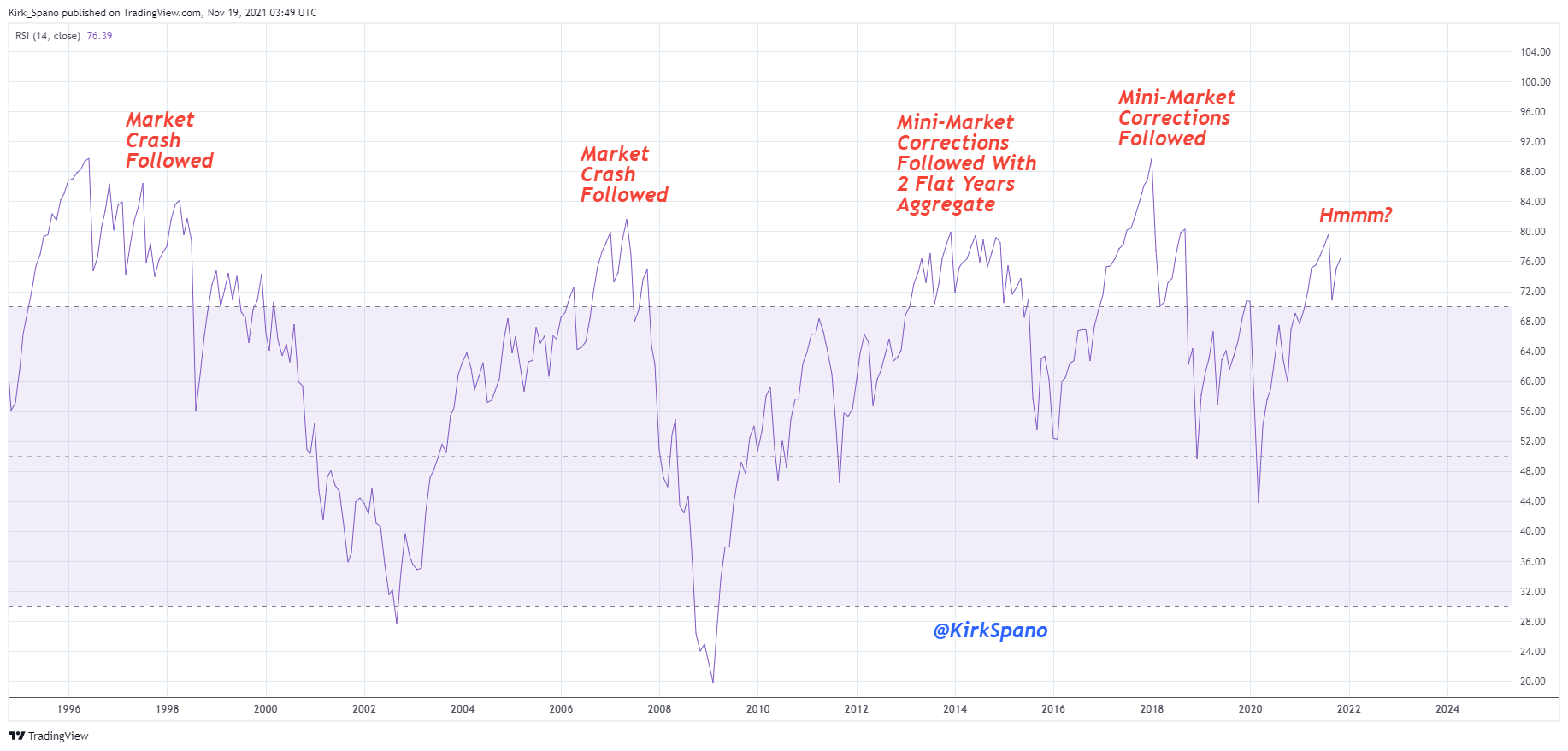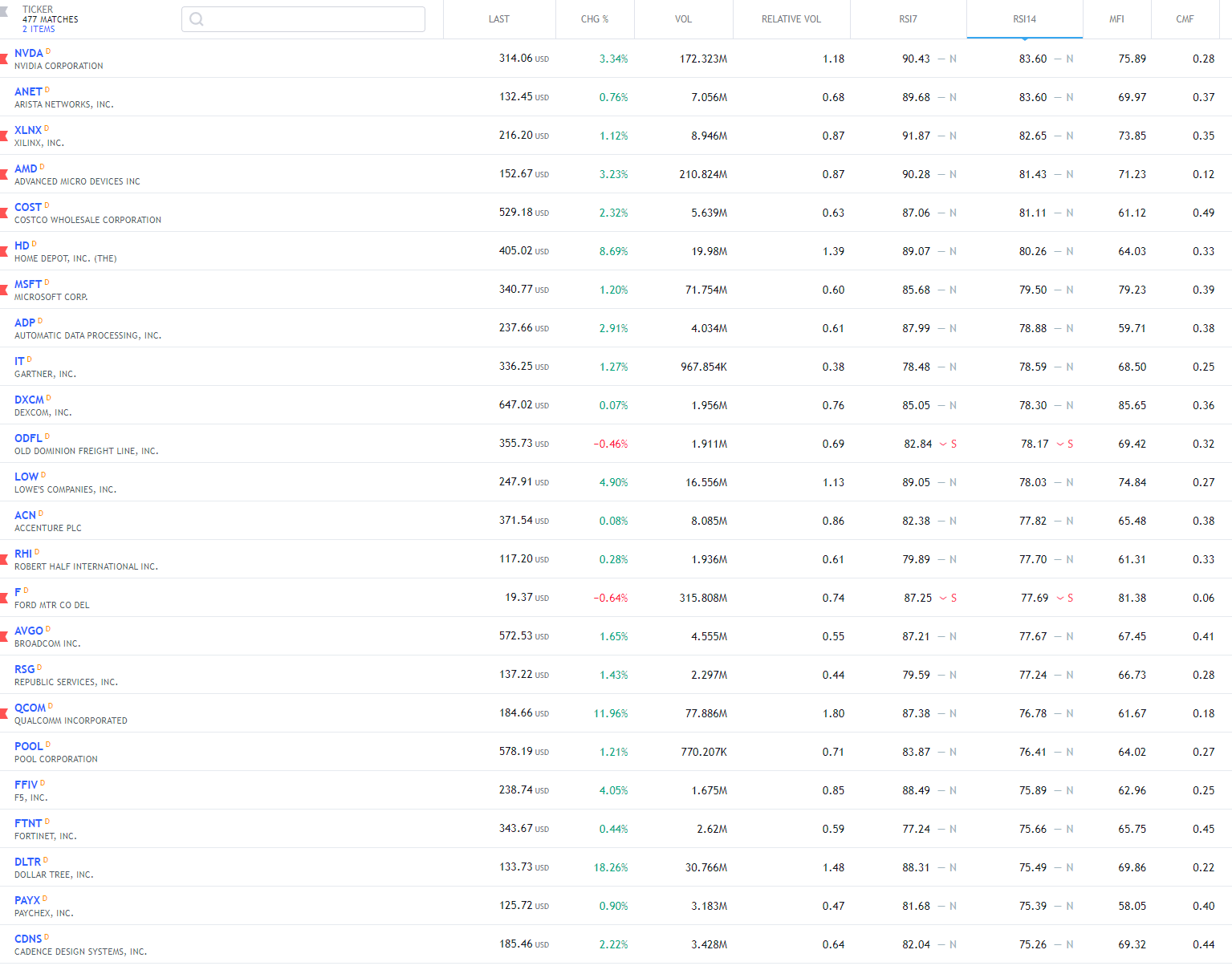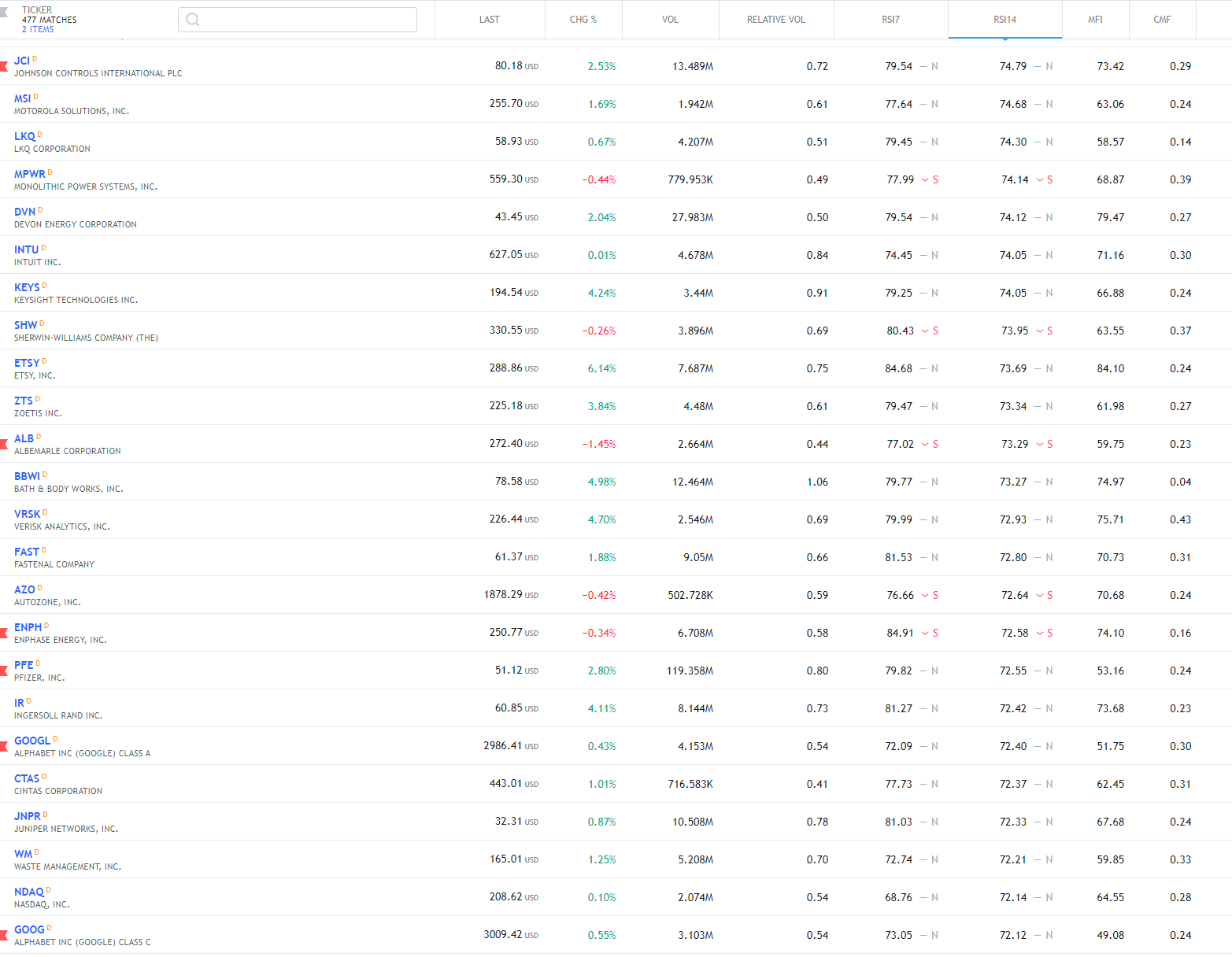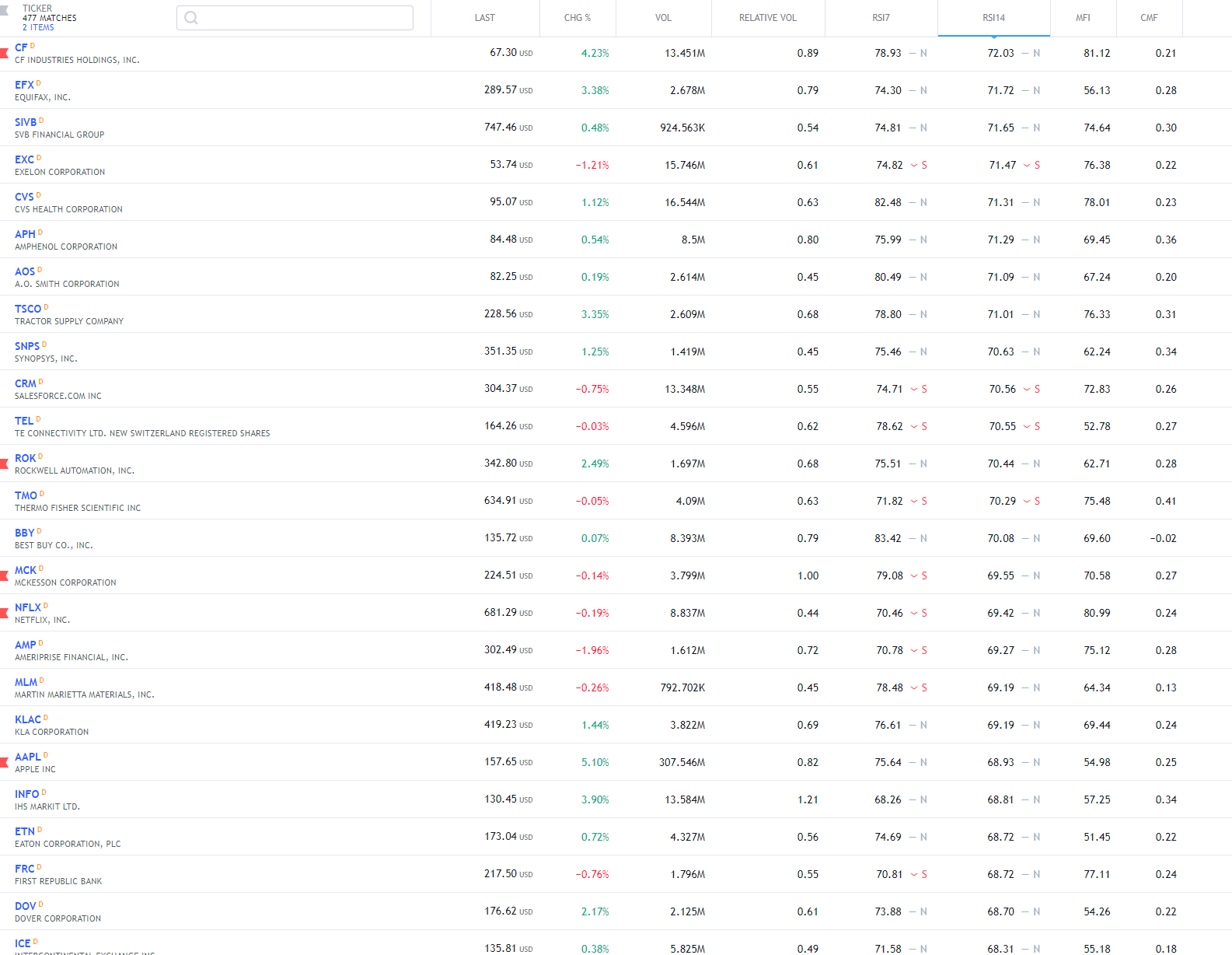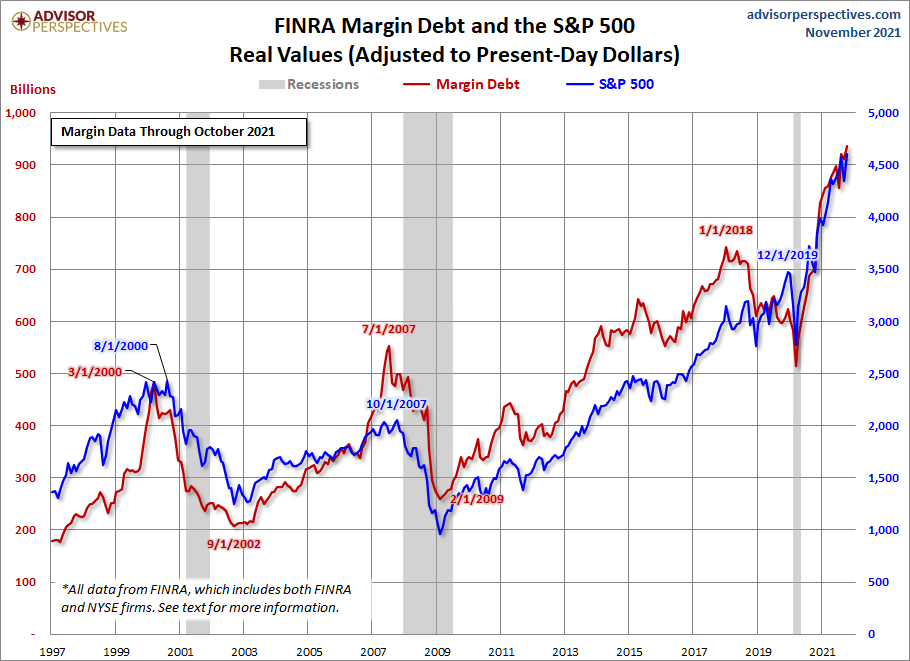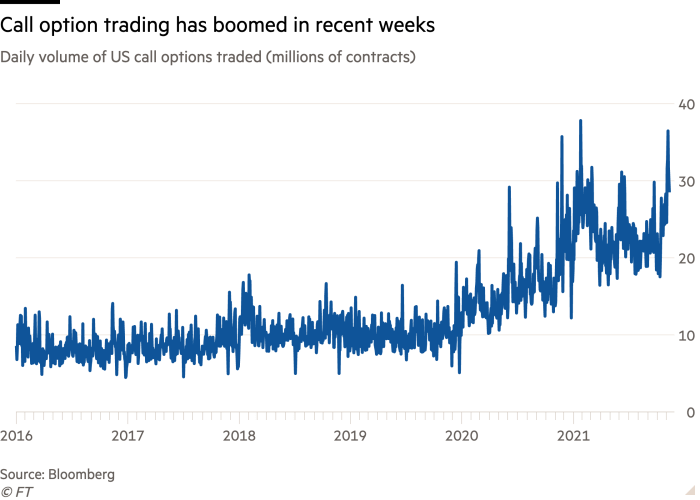Summary
- Stock market valuations and the Buffett valuation indicator are at historic highs.
- 411 of 500 S&P 500 stocks are trading above their 200-day moving average.
- The weekly RSI on SPY is overbought again just like before September mini-correction, this time the monthly RSI is overbought too, like 1999, 2007, 2013, 2018 and 2020.
- Leverage and call option volume are at all-time highs as well.
- Meanwhile, the Fed and Treasury are reducing liquidity.
D-Keine/E+ via Getty Images
If past is prologue, then we are about to see a very rough period in the stock market soon. So, while history might not repeat exactly, I can’t imagine it doesn’t rhyme.
I am not going to go down the road of Michael Burry, Jeremy Grantham or Jim Rogers and predict potentially the greatest crash since the Great Depression or another financial crisis, but, I will say, things sure do remind me of 1999 again.
And, while I do believe the Fed weirdly intends to be a benevolent thief, their real mission is to protect the dollar, which means the greenback will get stronger before it gets weaker again. A stronger dollar will make almost all asset prices fall, at least short term.
I believe the broad S&P 500 (SPX) (SPY) (VOO) stock market index stands a very good chance of behaving a lot like 2018 in 2022. I also think the rest of the decade could look a lot like it did from 2000 to 2009.
Indexers could be in for a lot of running up and down hills only to find themselves about where they began over the next 7 to 10 years.
The Great Divergence is about to begin. Quality and growth will separate themselves from the mediocre and worse. Let the Zombie hunting and Meme swatting begin. It won’t end for years.
Volatility Is Starting
Back in August, I said that:
Stock Market Correction Is Due And It Could Be Deep
I reminded you a few weeks ago with:
The Fed Warned You, Are You Going To Fight The Fed?
Now, the stock market is starting to react in the way that I warned it probably would to the Fed’s QE Taper. Slightly lower liquidity has already caused more volatility. What happens when liquidity is even lower?
Between now and year-end, I would expect volatility to continue. I think it will be particularly volatile at least two times next year, much like 2018.
While the January Effect has no perfect answer, the two big factors seem to be retirement plan inflows and the post new tax year moves of traders. If profitable 2020 traders sell into retirement plan inflows in January, by sometime later in the quarter as retirement plan and possibly foreign investment slow down, we could see the first correction of the year.
If the year is negative come Q4 and the Fed hasn’t backed off by then, as I have stated I think very well could happen, then a very 2018 like fourth quarter could occur.
Of course, volatility is not all bad.
“Look at market fluctuations as your friend rather than your enemy; profit from folly rather than participate in it.” Warren Buffett, emphasis added by author
“Investors should treat volatility as a friend. High volatility permits an investor to purchase stocks that are particularly depressed and to sell stocks when they are selling at particularly high prices. The greater the volatility, the greater the opportunity to purchase stocks at very low prices and then sell stocks at very high prices.” Ed Wachenheim, emphasis added by author
And, there’s the thing. I have to believe a lot of people want to book their profits next year by selling at very high prices given that capital gains rates won’t be any higher.
Historic Overvaluation
I know, I know, valuations don’t matter. It’s all the sentiment of crowds. Well, let me tell you something, shhh, close the door, I heard this saying once: Don’t fight the Fed. Why? Because liquidity speaks, sentiment listens (more on that coming).
In fact, the whole argument of many who justify the high valuations is that the “Fed has their back.” Well, what if other things are more important to the Fed, at least for a while. Do valuations matter then?
Well, maybe these valuations will:
Massive Overbought Conditions
Investors got away with one in September I think. The Fed still hadn’t pulled back, so there was a heckuva rebound rally after a piddly 5% correction. With the Fed tightening, rallies are likely to be fewer and smaller.
Let’s understand how overbought the stock market is on the easy money right now. Here’s the SPY Relative Strength Index [RSI] on a weekly basis.
Let’s take a look at the monthly RSI going further back.
Here’s what I think we can say most definitely: there’s probably not much upside left in the short run.
I would remind you that the Fed was tightening in 2000 as the stock market peaked and then fell dramatically. While we do not know if the stock market is right at its peak, it’s close, and the Fed is tightening again.
Here’s a look at S&P 500 stocks that are overbought right now, based on the RSI. It’s an unusually long list.
What you’re not seeing is that nearly 100 other stocks are on the verge of being overbought. Stocks marked with red by the way are stocks we were invested in or at least on our Very Short List (cute name for our screened watch list) of about 200 companies.
Here’s a crazy stat. According to a Stock Rover screen I ran, 411 stocks on the S&P 500 are over their 200-day moving average. I’m not sure if that’s ever happened before other than this year. I could be wrong that it’s a record, but if it’s not, it’s close.
Overleveraged
Here’s where leverage should wake you up a bit. When liquidity is reduced, leverage is generally at least proportionately reduced and usually more.
So, think about this. We are seeing record margin and call volume.
If calls expire worthless, that sets up the potential for margin calls on a lot of accounts. I’m not so sure it will be exceptionally damaging this first go around, but it could be.
It could also be a warning that turns the Reddit and other Millennial traders into short selling or put buying opportunists. Last year I asked:
Will Young Traders Flip The Option Switch To Cause A Crash?
I think the answer is clearly yes. Do you read Reddit? Oh, you should. Why? Because:
Macro Dashes – Millennials Are The Market’s Most Important Money
So, I see one of two or both scenarios playing out.
First, there will definitely be accounts blown up with record high valuations, running into substantial overbought conditions on the back of leverage (call buying) upon leverage (margin).
Second, as people get scared, we know that old men panic the worst and sell at all the wrong times.
MIT Study Finds Older Men Are More Likely to Panic Sell Stocks
And, 2a, the Millennials, if they can make a buck selling short or buying puts, they’ll do it. I’m telling you, while they don’t understand everything thing they are doing based on what I have read and heard, they are opportunists and clearly lean towards trend trading, at least that’s how it appears to me.
If you want to take profits because it would impact your lifestyle to deal with a year or two of bear market or a decade of choppy markets, I’d again suggest trimming now, not later. Don’t try to be too perfect.
Trading Is Hyperactive Already
I get volume alerts from Stock Rover every day. I monitor about 300 stocks that have passed some sort of proprietary screening or got my interest for a hot minute somehow, as well as, about 150 ETFs.
My alerts are not set low. For a stock to trigger an alert, it has to have 70% more volume than average. For an ETF to trigger an alert, it has to have 30% above average volume.
Usually, there are two to four emails per day with from one to five alerts each. Today there were five emails and a total of 46 alerts. Here’s an example of the last email of the day [I removed many of my tracking parameters to shorten the excerpt]:
| You have 46 new alerts. Only the first 10 are included below. Login to Stock Rover to see the full list. |
| SNEJF in VSL+’s volume at 2,655 exceeded the 1-month average volume by 83.36%. |
| The alert triggered on Thu Nov 18, 2021 at 12:48 PM ET. |
| TDOC in VSL+’s volume at 5,026,925 exceeded the 1-month average volume by 75.66%. |
| The alert triggered on Thu Nov 18, 2021 at 01:00 PM ET. |
| INDS in ETFavorites+’s volume at 70,383 exceeded the 1-month average volume by 35.60%. |
| The alert triggered on Thu Nov 18, 2021 at 01:12 PM ET. |
| GH in VSL+’s volume at 1,465,049 exceeded the 1-month average volume by 73.50%. |
| The alert triggered on Thu Nov 18, 2021 at 01:12 PM ET. | |
| EMQQ in ETFavorites+’s volume at 223,500 exceeded the 1-month average volume by 36.46%. |
| The alert triggered on Thu Nov 18, 2021 at 01:35 PM ET. |
| LSXMK in VSL+’s volume at 1,069,920 exceeded the 1-month average volume by 72.41%. |
| The alert triggered on Thu Nov 18, 2021 at 02:03 PM ET. |
| U in VSL+’s volume at 7,082,013 exceeded the 1-month average volume by 74.41%. |
| The alert triggered on Thu Nov 18, 2021 at 02:18 PM ET. |
| KWEB in ETFavorites+’s volume at 18,610,160 exceeded the 1-month average volume by 35.06%. |
| The alert triggered on Thu Nov 18, 2021 at 02:18 PM ET. |
| NVDA in VSL+’s volume at 64,277,716 exceeded the 1-month average volume by 71.21%. |
| The alert triggered on Thu Nov 18, 2021 at 02:29 PM ET. |
| APSG in VSL+’s volume at 506,482 exceeded the 1-month average volume by 70.16%. |
| The alert triggered on Thu Nov 18, 2021 at 02:29 PM ET. |
It went on and on. So, that’s about 4x more volume alerts today than normal. Wow. Some of that has to do with options expiration, but it usually doesn’t bump this hard.
So, here’s a question given that a lot of calls are very short-term in nature for traders: if many stocks trade below call strike prices Friday, does that drive a spiral down as margin calls might get triggered Monday?
Maybe not this time, but I think eventually. The volatility is already hitting certain stocks hard.
2018 Redux & A Lost Decade For Indexers?
Here’s what I can tell you having seen reactions to 2000 and 2008 valuations and overbought markets. The end result won’t be good for a lot of people. And, as calls expire worthless and margin calls come in, the fall in prices can be every bit as severe as March 2020.
It would not surprise me to see all but the very best companies go back to somewhere around Q1 2020 prices. I’m not sure the high end of that quarter or the lower. I suspect the higher unless something horrible happens to the economy.
There’s a lot of good arguments to the S&P 500 going down to the middle $300s. I think a price under $400 is all but assured sometime in 2022.
There’s a possibility that if the Fed over tightens, we see the SPY under $300 again, but I doubt it.
The rest of the decade could be very range bound. Why? Because by my count, there are nearly 150 S&P 500 stocks with weak balance sheets and no real growth. That means that if they can’t keep reworking their debt, they have problems.
Remember, many big companies got help refinancing from the Fed indirectly when they supported the broad corporate bond market by buying bond ETFs. I don’t think we can or should count on that again – though anything is possible.
There’s a lot of disruptors in the economy that can be tomorrow’s S&P 500 companies, I plan to invest in a basket of those. Short of another massive economic shock (which is possible because we do dumb things), they’ll emerge and creative destruction will occur.
The process of swapping out a 100 to 200 companies on the S&P 500 the rest of the decade will take time for economic business cycles, bondholders to demand returns (already starting) and corrections. I think it’s very possible the SPY doesn’t break $600 until very late in the decade.
That’s not a lot of upside for indexers or those who pick bad stocks outright.
Investment Closing Quick Thought
By now, you should understand what I’m getting at. The stock market is in a new dangerous phase.
It took longer to get here than I thought, so if you want to doubt me, check others who are saying similar. I’m just a messenger. For what it’s worth, I think the rally lasted mainly for two reasons.
- We’ve made our way through Coronavirus in a gross way and by next year it seems it’ll be more like a flu for vaccinated people.
- The Fed didn’t just fire a bazooka to fight the global economic shutdown, it was a monetary mushroom cloud.
Going forward short run, we need to be very careful about what we buy. The small and midcap long-term growth we like will be volatile and we will get our chance to fill out positions. The quality large caps should come to us too, in time, as indexers eventually panic sell which is historic extreme high probability while the traders kill zombies.
And, as I said above, volatility isn’t all bad.
We should see very attractive prices again on some of our already appreciated stocks [think Ford (F), (LSXMK), (MP), (SPWR), (BRK.B), (TAN), (ARKK)…] and larger quality companies that we want back in our portfolio [think (MSFT), (GOOG), (AAPL), (SOXX), (QQQ…)], but we likely have to wait until next year sometime.
If we do see the 2018 scenario, that will also open a window for a trade: buy early year, sell mid-year, buy again for the long-term toward the end of the year. We’ll see how it plays out, maybe the Fed is nicer than they say they’re going to be. That’s my guess, but it doesn’t mean the seas won’t get rough first.
Prepare your bucket to catch the golden rain when the storms come. Being a good stock picker and asset allocator via the right ETFs will pay off as the world becomes more sustainable on the back of technology and the clean energy transition.
Author
Kirk Spano
CEO/CIO — Fundamental Trends
Kirk is an Accredited Investment Advisor and founder of Fundamental Trends. He is an economist by education and has managed money through major cycles since 1995. Kirk has been highly successful in helping DIY investors make sense of the investment world, and profit in stocks, ETFs and crypto.


